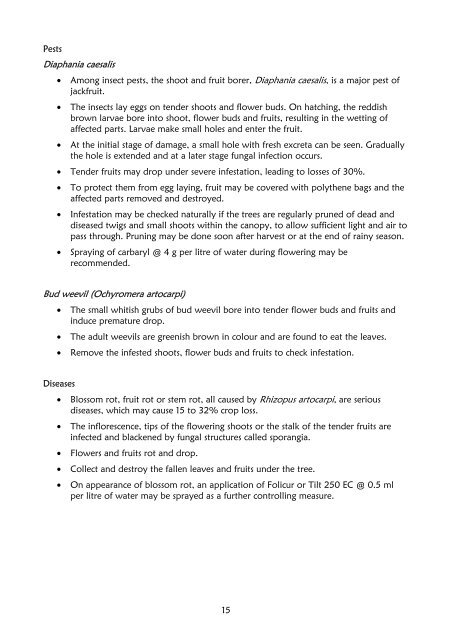Jackfruit extension manual.pdf - Crops for the Future
Jackfruit extension manual.pdf - Crops for the Future
Jackfruit extension manual.pdf - Crops for the Future
You also want an ePaper? Increase the reach of your titles
YUMPU automatically turns print PDFs into web optimized ePapers that Google loves.
Pests<br />
Diaphania caesalis<br />
• Among insect pests, <strong>the</strong> shoot and fruit borer, Diaphania caesalis, is a major pest of<br />
jackfruit.<br />
• The insects lay eggs on tender shoots and flower buds. On hatching, <strong>the</strong> reddish<br />
brown larvae bore into shoot, flower buds and fruits, resulting in <strong>the</strong> wetting of<br />
affected parts. Larvae make small holes and enter <strong>the</strong> fruit.<br />
• At <strong>the</strong> initial stage of damage, a small hole with fresh excreta can be seen. Gradually<br />
<strong>the</strong> hole is extended and at a later stage fungal infection occurs.<br />
• Tender fruits may drop under severe infestation, leading to losses of 30%.<br />
• To protect <strong>the</strong>m from egg laying, fruit may be covered with poly<strong>the</strong>ne bags and <strong>the</strong><br />
affected parts removed and destroyed.<br />
• Infestation may be checked naturally if <strong>the</strong> trees are regularly pruned of dead and<br />
diseased twigs and small shoots within <strong>the</strong> canopy, to allow sufficient light and air to<br />
pass through. Pruning may be done soon after harvest or at <strong>the</strong> end of rainy season.<br />
• Spraying of carbaryl @ 4 g per litre of water during flowering may be<br />
recommended.<br />
Bud weevil (Ochyromera artocarpi)<br />
• The small whitish grubs of bud weevil bore into tender flower buds and fruits and<br />
induce premature drop.<br />
• The adult weevils are greenish brown in colour and are found to eat <strong>the</strong> leaves.<br />
• Remove <strong>the</strong> infested shoots, flower buds and fruits to check infestation.<br />
Diseases<br />
• Blossom rot, fruit rot or stem rot, all caused by Rhizopus artocarpi, are serious<br />
diseases, which may cause 15 to 32% crop loss.<br />
• The inflorescence, tips of <strong>the</strong> flowering shoots or <strong>the</strong> stalk of <strong>the</strong> tender fruits are<br />
infected and blackened by fungal structures called sporangia.<br />
• Flowers and fruits rot and drop.<br />
• Collect and destroy <strong>the</strong> fallen leaves and fruits under <strong>the</strong> tree.<br />
• On appearance of blossom rot, an application of Folicur or Tilt 250 EC @ 0.5 ml<br />
per litre of water may be sprayed as a fur<strong>the</strong>r controlling measure.<br />
15

















